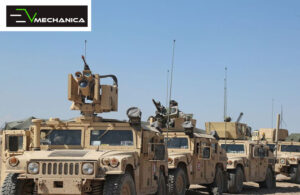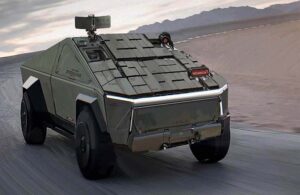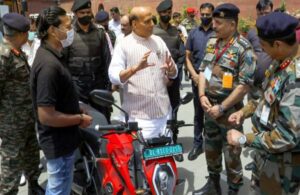 Stationed at the eye of the vortex titled as climate change, Electric Vehicles (EVs) have become the core component that can work towards stabilizing the increasingly unbalanced forces of carbonization and net emissions engulfing the entire globe.
Stationed at the eye of the vortex titled as climate change, Electric Vehicles (EVs) have become the core component that can work towards stabilizing the increasingly unbalanced forces of carbonization and net emissions engulfing the entire globe.
Becoming a beacon of mitigating effective strategy, EVs are considered the most preferred type of transportation that is non-polluting, lightweight and has cost-free maintenance.
Keeping these points in mind along with gauging the possible potential of this new generation vehicle type, the majority of industries have come forward to integrate their technologies to develop innovative solutions.
With the speed of development witnessed in the Electric mobility adoption across the world, defense sector has also recognized the unlimited potential of these EVs to transform the capabilities of their armored vehicles and logistical and tactical trucks towards a new domain.
Electric Vehicles (EVs) in Defence Sector are quickly becoming the new reality as the armed forces are inducting the utilization of electric trucks and vehicles in some of their barracks.
Despite facing some technical stumbling blocks in the complete integration of Electric Vehicles (EVs) in Defence Sector, some EVs are now actively deployed in a combat setting, wherein a distinct department has been created to research the new technology.
Though the rate of adoption of Electric Vehicles (EVs) in Defence Sector varies from country-to-country basis, the specific point of our discussion will be largely focused on the global EV scenario Vs. Indian Army’s rate of adoption of Electric Vehicles (EVs) in Defence Sector.
Global Layout of Electric Vehicles (EVs) in Defence Sector
 Following an upward learning curve of the rate of adoption of Electric Vehicles (EVs) in Defence Sector, hybrid vehicles are the primary focus of the US and UK armed forces before adopting fully electric vehicles in their fleet.
Following an upward learning curve of the rate of adoption of Electric Vehicles (EVs) in Defence Sector, hybrid vehicles are the primary focus of the US and UK armed forces before adopting fully electric vehicles in their fleet.
According to a recent announcement, US and UK armies have independently started commissioning the development of hybrid vehicles.
Showing its intention in the field of EV space, US Army has also sealed a contract with the University of Wisconsin to research how hybrid powertrains can be integrated into the fleet.
Similarly, UK’s Protected Mobility Engineering & Technical Support (PMETS) program was meant to electrify the MAN SV, Jackal and Foxhound vehicles.
Thus, offsetting an array of greening strategies that are now getting implemented by many armed forces toward the integration of Electric Vehicles (EVs) in Defence Sector.
Following the example of the UK and US-based model, many of the developed countries like Canada, and China have been attempting to search for a possible solution for how to charge Electric Vehicles (EVs) in Defence Sector.
India’s Stance on the Entry of Electric Vehicles (EVs) in Defence Sector
 Taking a resolute approach to the adoption of Electric mobility across the country, the Indian government launched National Electric Mobility Mission Plan (NEMMP) in 2013 to ramp up the adoption of EVs to save 9500 million liters of crude oil which amounts to ₹62,000 crores.
Taking a resolute approach to the adoption of Electric mobility across the country, the Indian government launched National Electric Mobility Mission Plan (NEMMP) in 2013 to ramp up the adoption of EVs to save 9500 million liters of crude oil which amounts to ₹62,000 crores.
Spurred under the Government’s initiatives, the Indian Army has formulated a plan to replace around 25% of their light vehicles, 38% of buses, and 48% of motorcycles deployed within their fleet with electric equivalents in a time-bound manner and select units.
Starting in August 2019, a specified fleet of 10 electric cars was inducted into the Indian Army, therefore marking the first entry of Electric Vehicles (EVs) into Defence Sector.
These Electric Cars were Mahindra’s eVerito which were procured for use by officials in New Delhi under the step to help curb emissions.
Later on, a demonstration of Electric Vehicles (EVs) in Defence Sector was given to Defence Minister Rajnath Singh, the Chief of Army Staff and other senior officers of the Indian Army in New Delhi on 22 April 2022.
The demonstration was carried out by some of the leading EV manufacturers including, Tata Motors, Perfect Metal Industries (PMI) and Revolt Motors who exhibited their EVs to the audience and informed about the enhancement in their technology and range of operation achieved during the past few years.
In a recent announcement, the Indian Army has decided to support the EV ecosystem in the army units, with the establishment of required infrastructure, including charging points for EVs, having at least one fast charger and 2-3 slow chargers.
Apart from this, the Army has also been planning to install solar-powered charging stations in a time-bound manner to facilitate the journey of Electric Vehicles (EVs) in Defence Sector.
